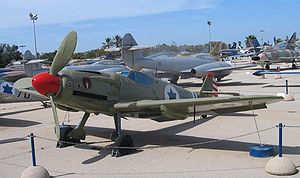Avia S-99
| S-199 | |
|---|---|
 |
|
| Role | Fighter aircraft |
| Manufacturer | Avia |
| Designer | Messerschmitt |
| First flight | March 1947 |
| Retired | 1957 |
| Primary users |
Czechoslovak Air Force Israeli Air Force |
| Produced | 1947–1949 |
| Number built | 603 |
| Developed from | Messerschmitt Bf 109 |
The Avia S-199 was a propeller-driven fighter aircraft built after World War II, notable as the first fighter obtained by the Israeli Air Force, and used during the 1948 Arab-Israeli War.
Constructed in Czechoslovakia, with parts and plans left over from Luftwaffe aircraft production, the aircraft had numerous problems and was generally unpopular with its pilots. Czechoslovak pilots nicknamed it Mezek ("Mule"), while in Israel it was officially known as the Sakeen ("knife" in Hebrew). In practice, the aircraft was more often called Messerschmitt or Messer (which also means "knife", in German and Yiddish).
Avia continued building Messerschmitt Bf 109G-6s after the war under the Avia S-99 name, at two aircraft factories in Czechoslovakia: one of them officially called závod Avia (Avia Plant) (1946–48) and závod Avia-Jiřího Dimitrova (Avia-George Dimitroff-Plant, 1948–49) in Čakovice near Prague, as a postwar corporative part of the Automobilové závody, n.p. [Automotive Works, National Corp.]. The other was named závod Vysočany (Vysočany Plant, 1948–49) in Prague, as a corporative part of Letecké závody, n.p. [Aviation Works, National Corp.] but soon ran out of the 109's Daimler-Benz DB 605 engine after many were destroyed during an explosion at a warehouse in Krásné Březno.
The S-199 continued to use the Bf 109G airframe but, with none of the original engines available, an alternative engine had to be used. It was decided that as a replacement for the original engine, the aircraft would use the same (Junkers Jumo 211 F) engine and propeller as the Heinkel He 111 bomber. The resulting combination of parts was an aircraft with extremely poor handling qualities. The substitute engine with the propeller lacked the responsiveness of the Daimler-Benz unit and the torque created by the massive paddle-bladed propeller made control very difficult. This, in combination with the 109's narrow-track undercarriage, made landings and takeoffs extremely hazardous.
...
Wikipedia
